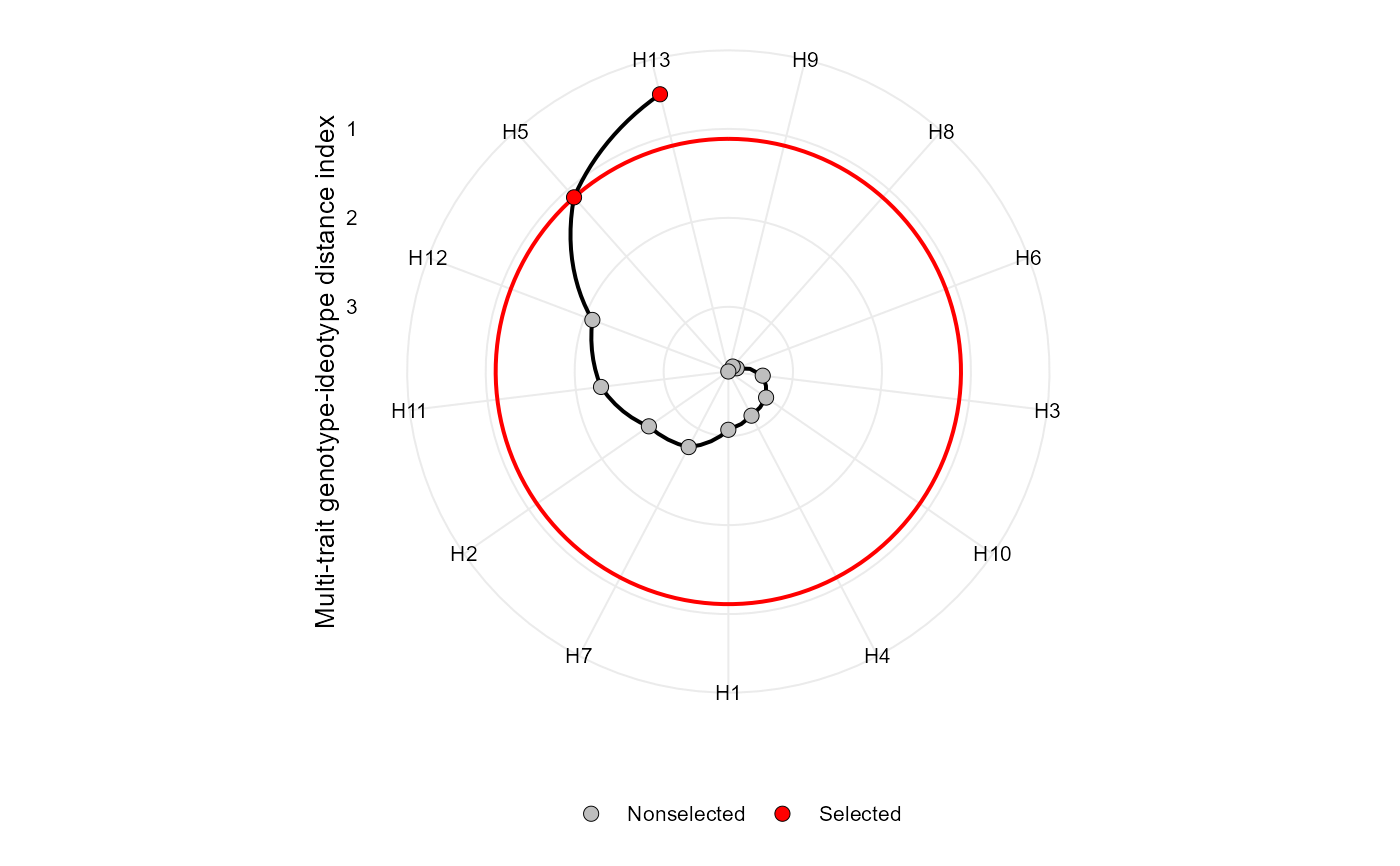Makes a radar plot showing the multi-trait genotype-ideotype distance index
Usage
# S3 method for mgidi
plot(
x,
SI = 15,
radar = TRUE,
type = "index",
position = "fill",
rotate = FALSE,
genotypes = "selected",
n.dodge = 1,
check.overlap = FALSE,
x.lab = NULL,
y.lab = NULL,
title = NULL,
arrange.label = FALSE,
size.point = 2.5,
size.line = 0.7,
size.text = 10,
width.bar = 0.75,
col.sel = "red",
col.nonsel = "gray",
legend.position = "bottom",
...
)Arguments
- x
An object of class
mgidi- SI
An integer (0-100). The selection intensity in percentage of the total number of genotypes.
- radar
Logical argument. If true (default) a radar plot is generated after using
coord_polar().- type
The type of the plot. Defaults to
"index". Usetype = "contribution"to show the contribution of each factor to the MGIDI index of the selected genotypes/treatments.- position
The position adjustment when
type = "contribution". Defaults to"fill", which shows relative proportions at each trait by stacking the bars and then standardizing each bar to have the same height. Useposition = "stack"to plot the MGIDI index for each genotype/treatment.- rotate
Logical argument. If
rotate = TRUEthe plot is rotated, i.e., traits in y axis and value in the x axis.- genotypes
When
type = "contribution"defines the genotypes to be shown in the plot. By default (genotypes = "selected"only selected genotypes are shown. Usegenotypes = "all"to plot the contribution for all genotypes.)- n.dodge
The number of rows that should be used to render the x labels. This is useful for displaying labels that would otherwise overlap.
- check.overlap
Silently remove overlapping labels, (recursively) prioritizing the first, last, and middle labels.
- x.lab, y.lab
The labels for the axes x and y, respectively. x label is set to null when a radar plot is produced.
- title
The plot title when
type = "contribution".- arrange.label
Logical argument. If
TRUE, the labels are arranged to avoid text overlapping. This becomes useful when the number of genotypes is large, say, more than 30.- size.point
The size of the point in graphic. Defaults to 2.5.
- size.line
The size of the line in graphic. Defaults to 0.7.
- size.text
The size for the text in the plot. Defaults to 10.
- width.bar
The width of the bars if
type = "contribution". Defaults to 0.75.- col.sel
The colour for selected genotypes. Defaults to
"red".- col.nonsel
The colour for nonselected genotypes. Defaults to
"gray".- legend.position
The position of the legend.
- ...
Other arguments to be passed from
ggplot2::theme().
Author
Tiago Olivoto tiagoolivoto@gmail.com
Examples
# \donttest{
library(metan)
model <- gamem(data_g,
gen = GEN,
rep = REP,
resp = c(KW, NR, NKE, NKR))
#> Evaluating trait KW |=========== | 25% 00:00:00
Evaluating trait NR |====================== | 50% 00:00:00
Evaluating trait NKE |================================ | 75% 00:00:00
Evaluating trait NKR |===========================================| 100% 00:00:00
#> Method: REML/BLUP
#> Random effects: GEN
#> Fixed effects: REP
#> Denominador DF: Satterthwaite's method
#> ---------------------------------------------------------------------------
#> P-values for Likelihood Ratio Test of the analyzed traits
#> ---------------------------------------------------------------------------
#> model KW NR NKE NKR
#> Complete NA NA NA NA
#> Genotype 0.0253 0.0056 0.00952 0.216
#> ---------------------------------------------------------------------------
#> Variables with nonsignificant Genotype effect
#> NKR
#> ---------------------------------------------------------------------------
mgidi_index <- mgidi(model)
#>
#> -------------------------------------------------------------------------------
#> Principal Component Analysis
#> -------------------------------------------------------------------------------
#> # A tibble: 4 × 4
#> PC Eigenvalues `Variance (%)` `Cum. variance (%)`
#> <chr> <dbl> <dbl> <dbl>
#> 1 PC1 2.42 60.6 60.6
#> 2 PC2 1.19 29.8 90.3
#> 3 PC3 0.32 8 98.3
#> 4 PC4 0.07 1.66 100
#> -------------------------------------------------------------------------------
#> Factor Analysis - factorial loadings after rotation-
#> -------------------------------------------------------------------------------
#> # A tibble: 4 × 5
#> VAR FA1 FA2 Communality Uniquenesses
#> <chr> <dbl> <dbl> <dbl> <dbl>
#> 1 KW -0.9 0.04 0.82 0.18
#> 2 NR -0.92 -0.12 0.87 0.13
#> 3 NKE -0.7 -0.69 0.96 0.04
#> 4 NKR 0.05 -0.98 0.97 0.03
#> -------------------------------------------------------------------------------
#> Comunalit Mean: 0.9033994
#> -------------------------------------------------------------------------------
#> Selection differential
#> -------------------------------------------------------------------------------
#> # A tibble: 4 × 11
#> VAR Factor Xo Xs SD SDperc h2 SG SGperc sense goal
#> <chr> <chr> <dbl> <dbl> <dbl> <dbl> <dbl> <dbl> <dbl> <chr> <dbl>
#> 1 KW FA1 147. 163. 16.2 11.0 0.659 10.7 7.27 increase 100
#> 2 NR FA1 15.8 17.4 1.63 10.3 0.736 1.20 7.60 increase 100
#> 3 NKE FA1 468. 532. 64.0 13.7 0.713 45.6 9.74 increase 100
#> 4 NKR FA2 30.4 31.2 0.814 2.68 0.452 0.368 1.21 increase 100
#> ------------------------------------------------------------------------------
#> Selected genotypes
#> -------------------------------------------------------------------------------
#> H13 H5
#> -------------------------------------------------------------------------------
plot(mgidi_index)
 # }
# }
